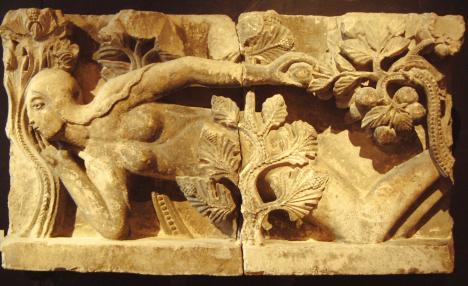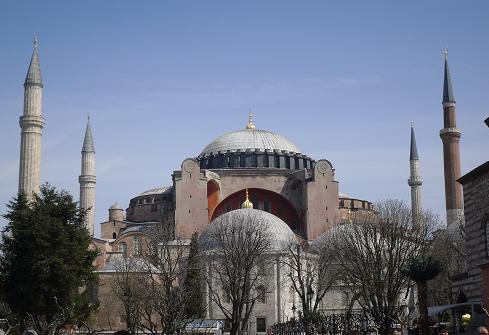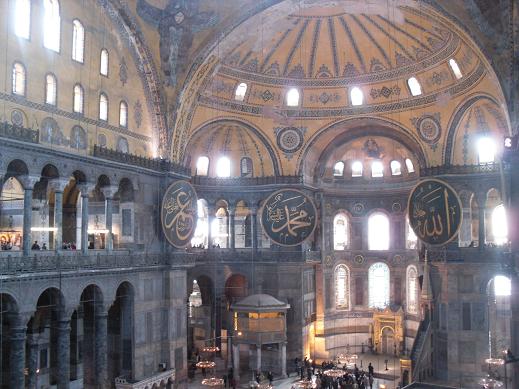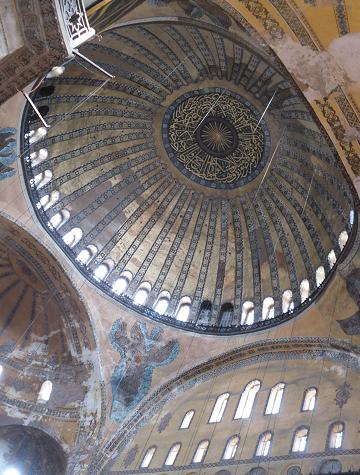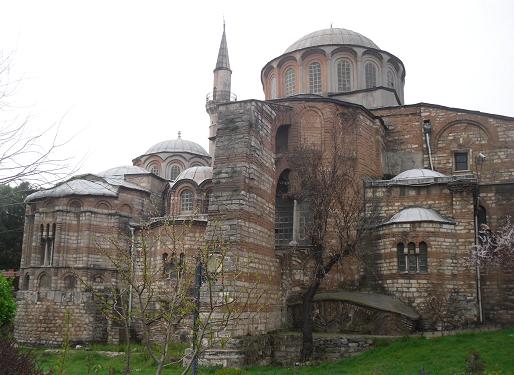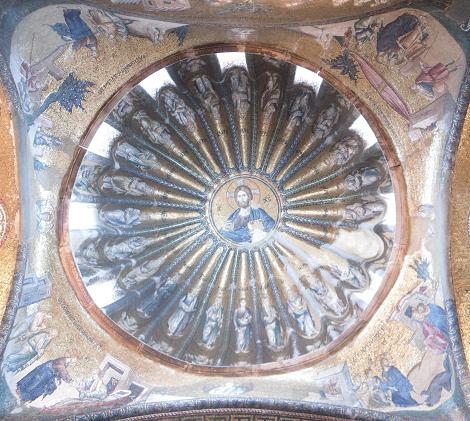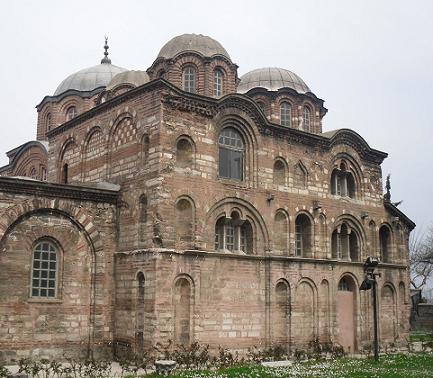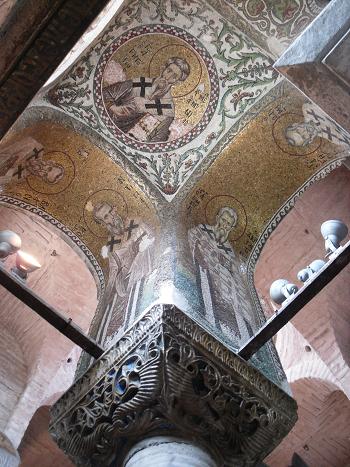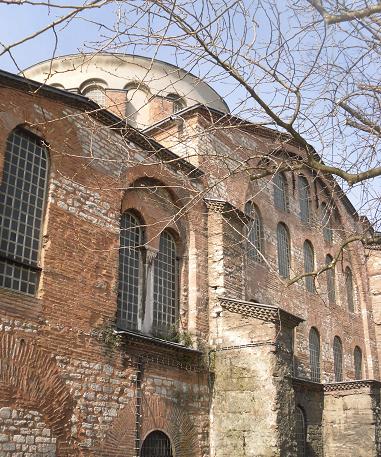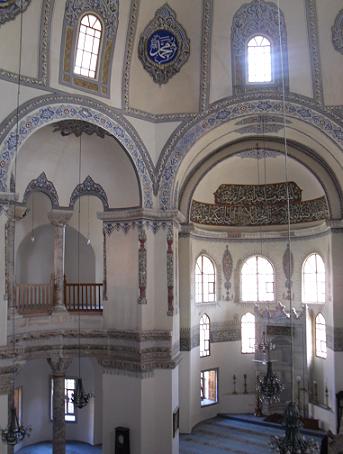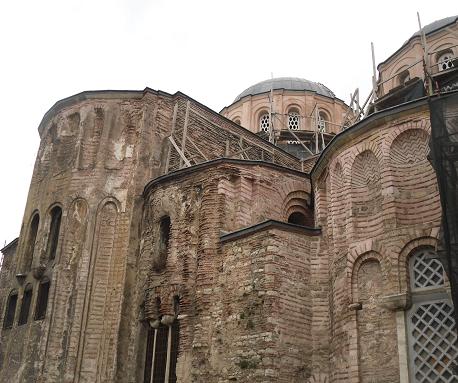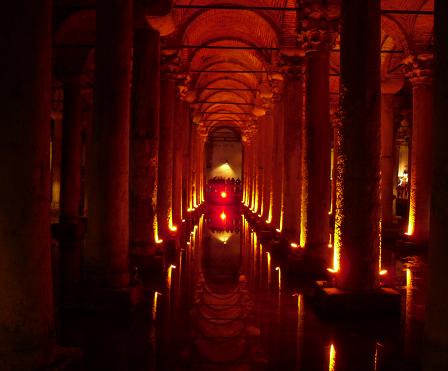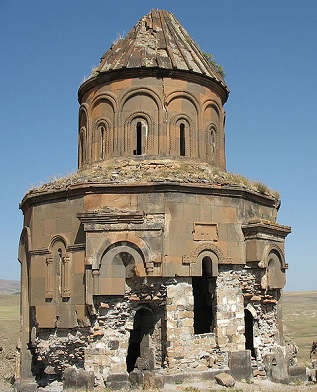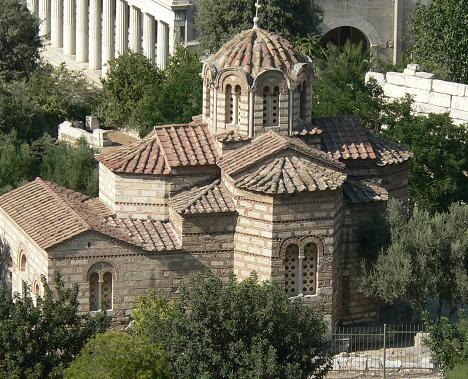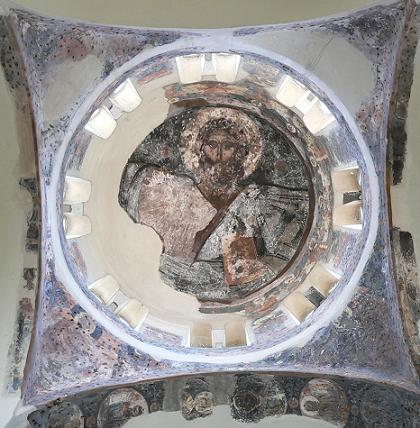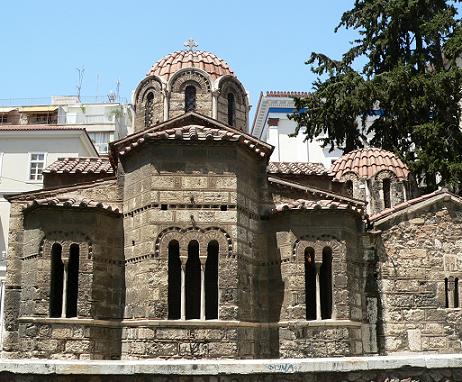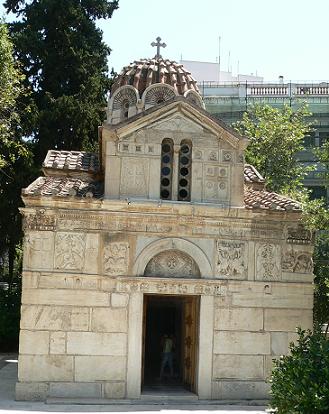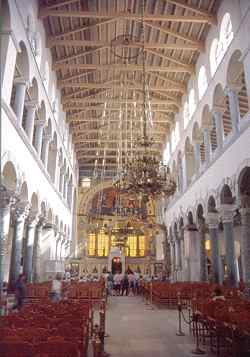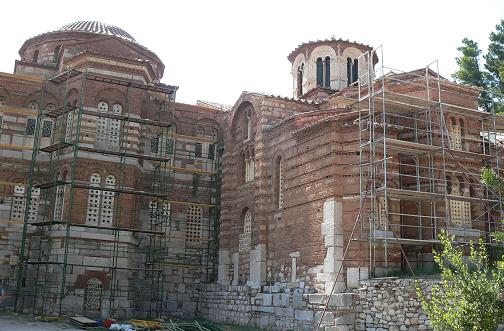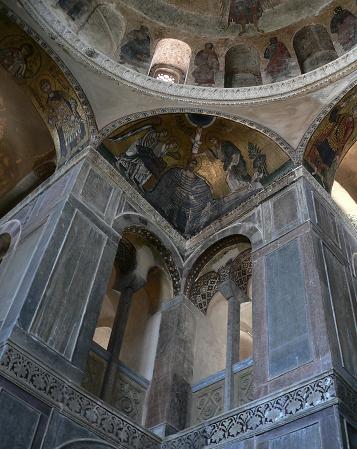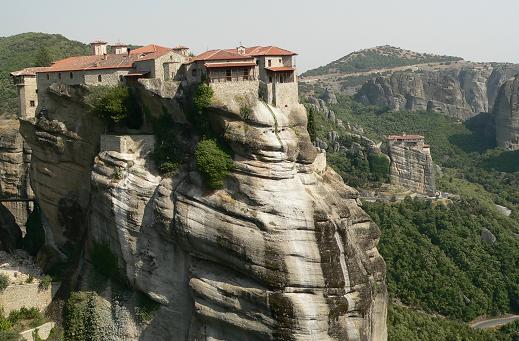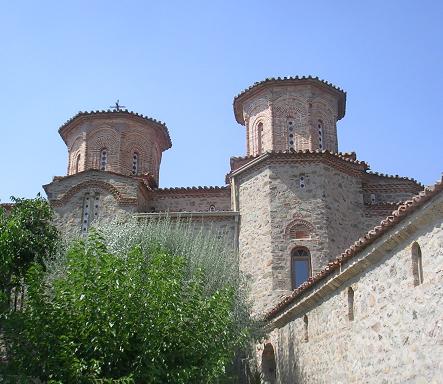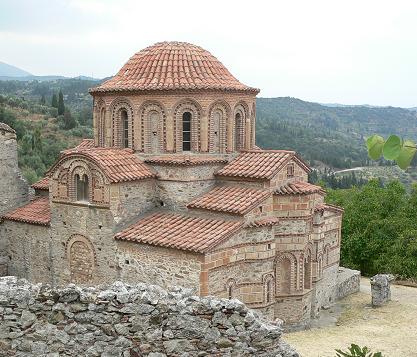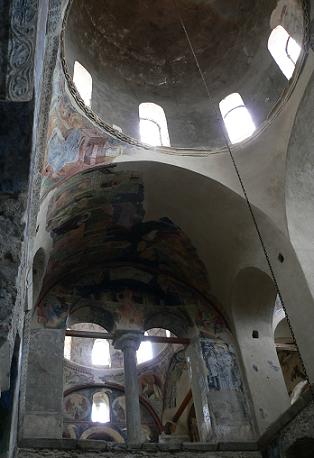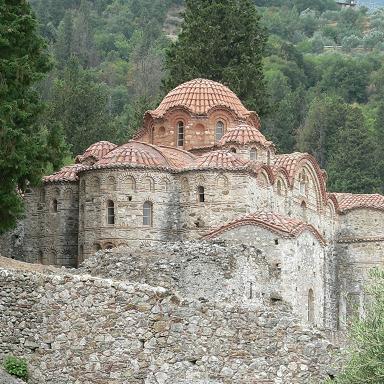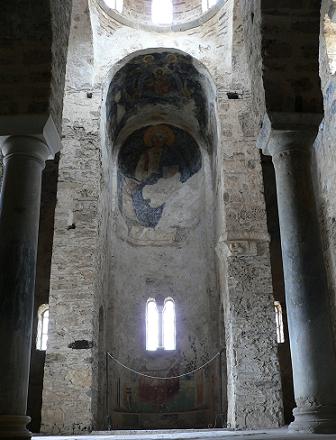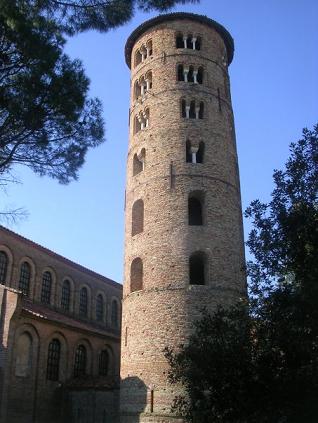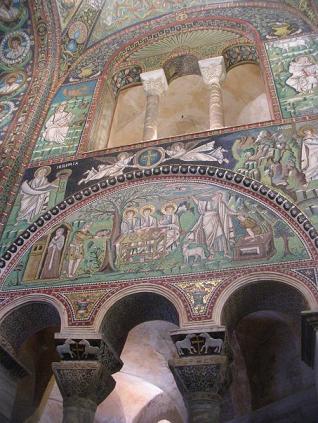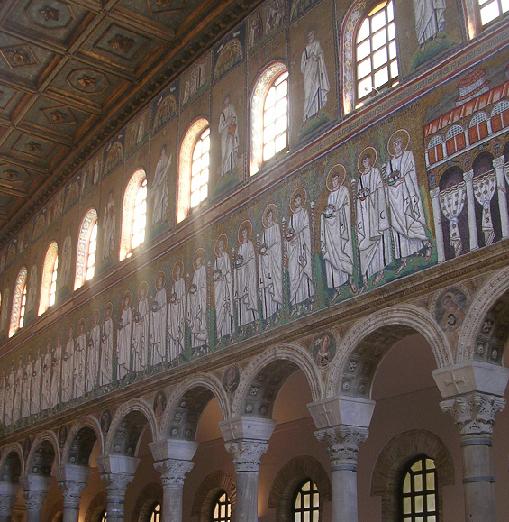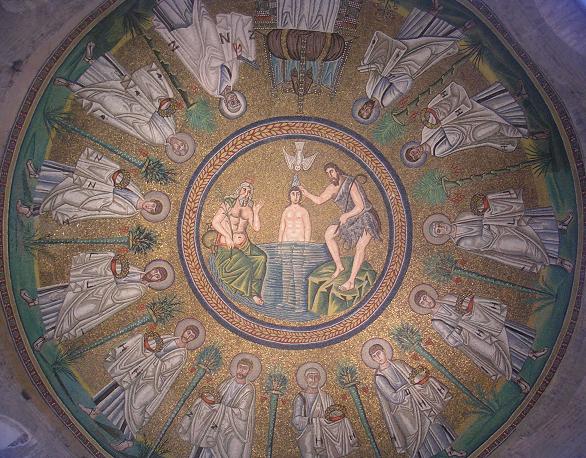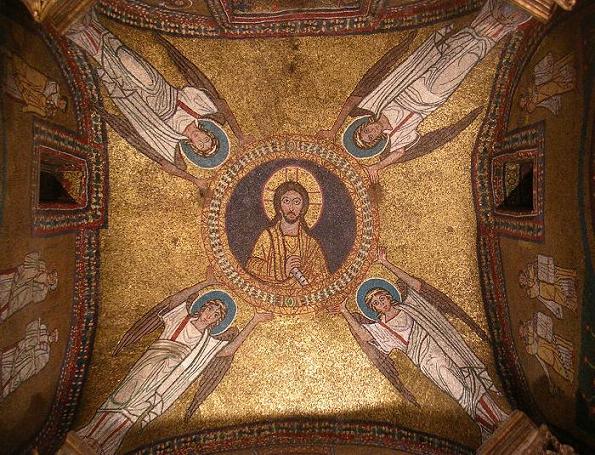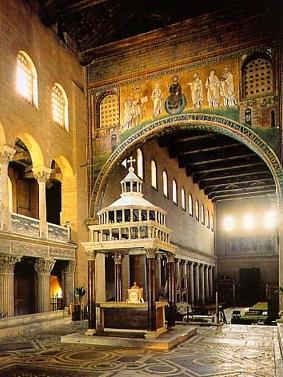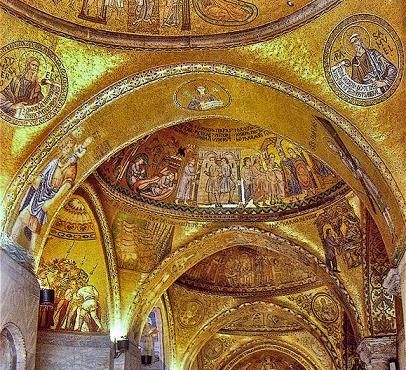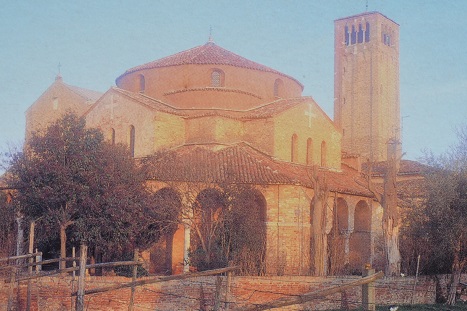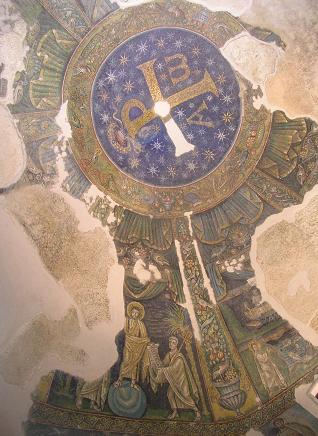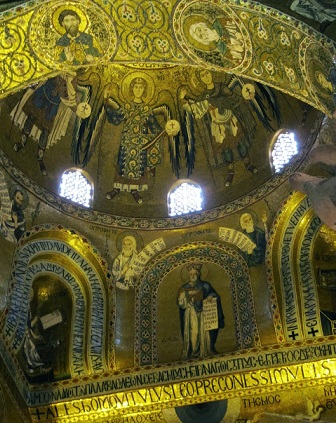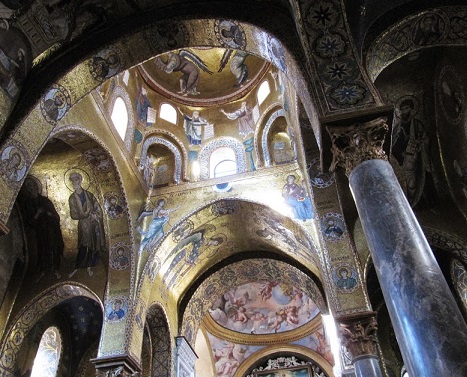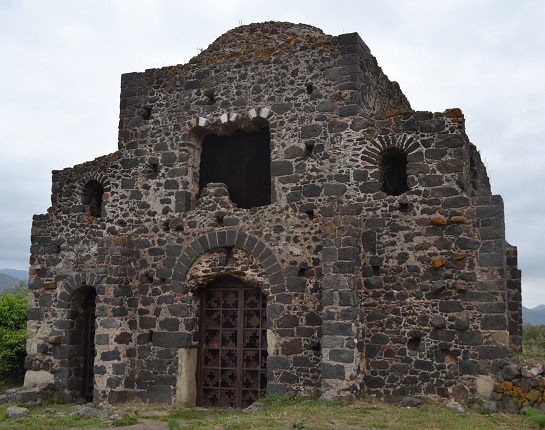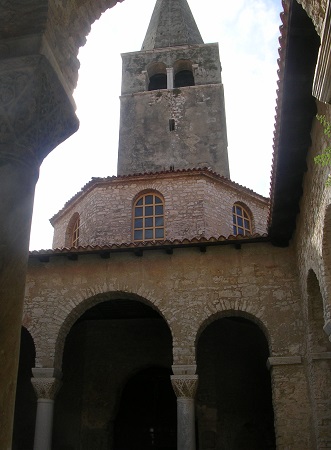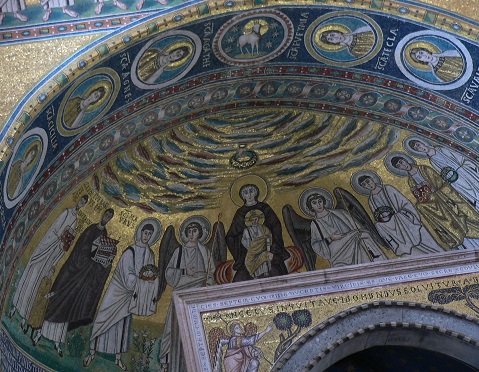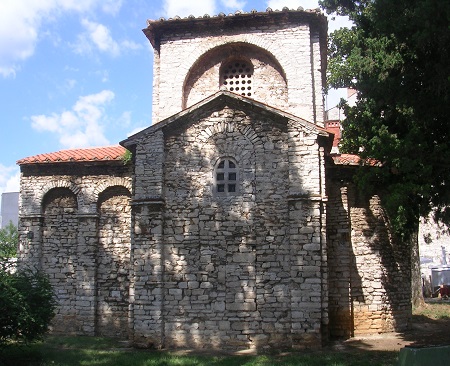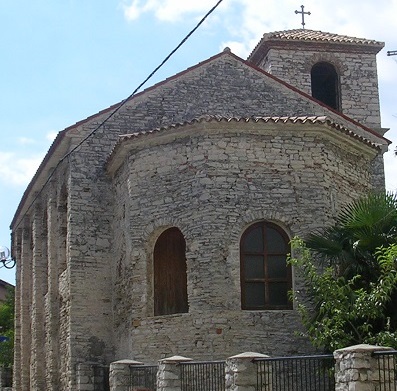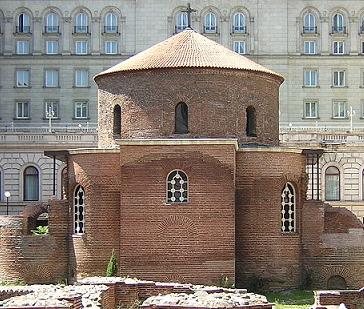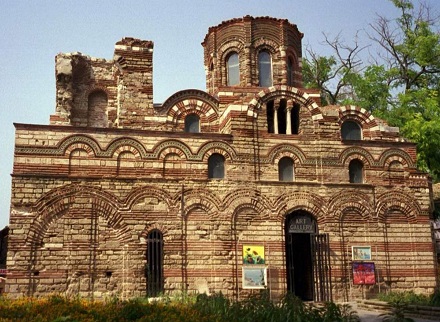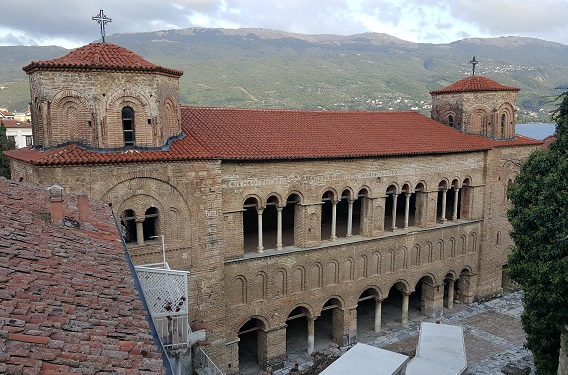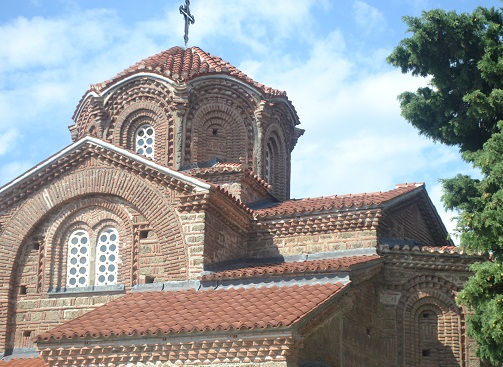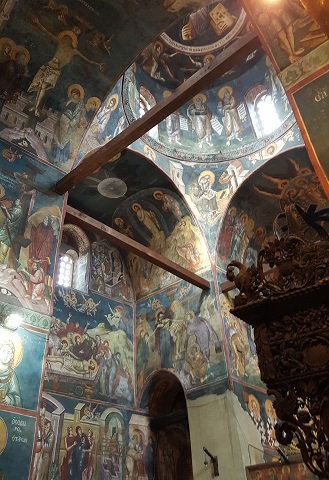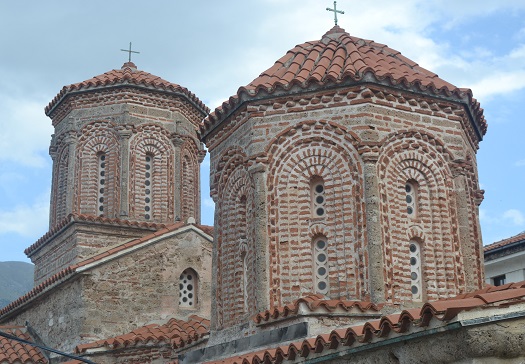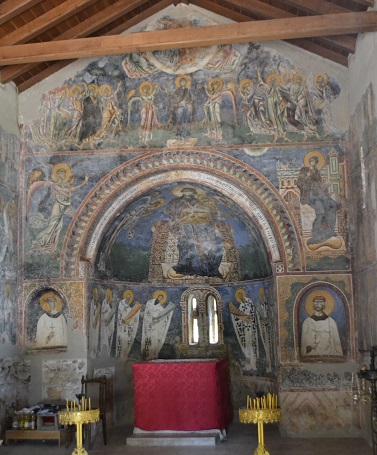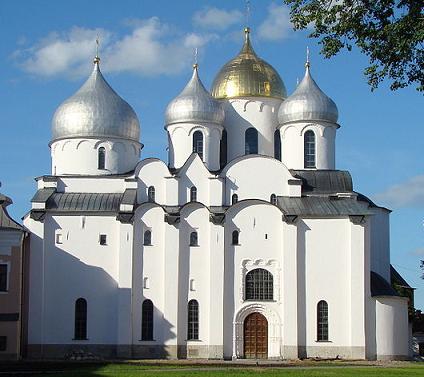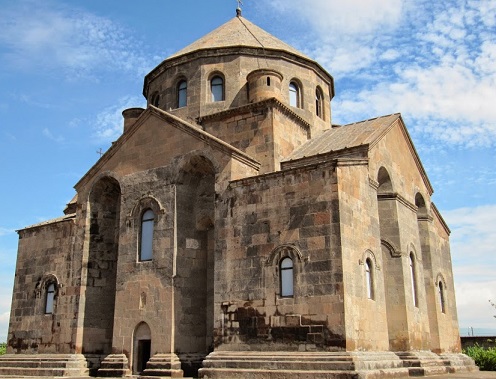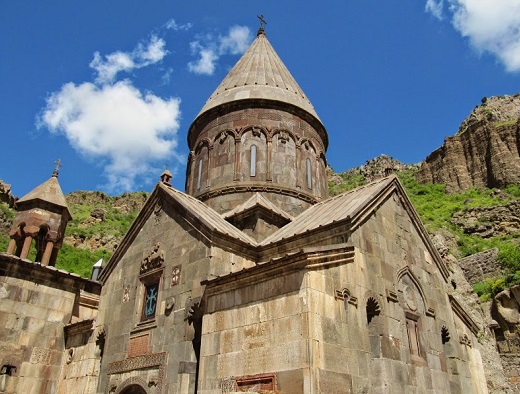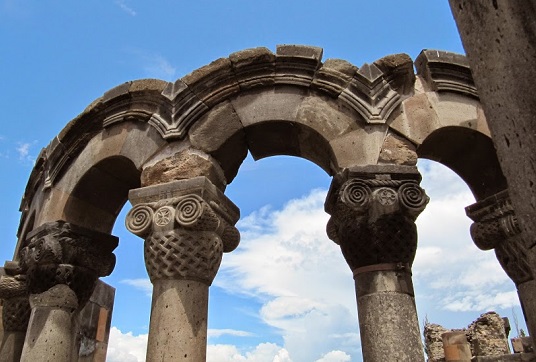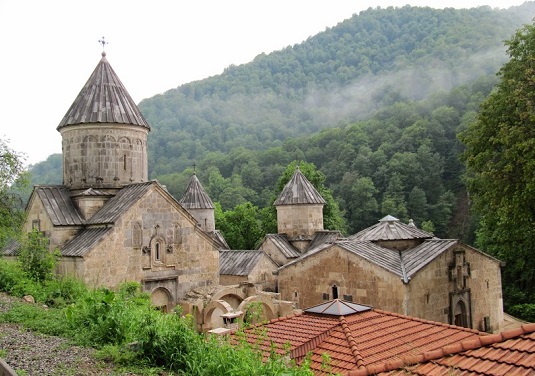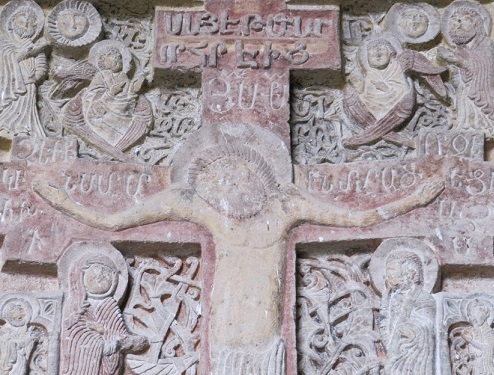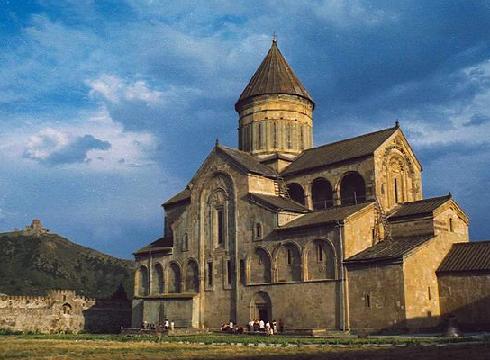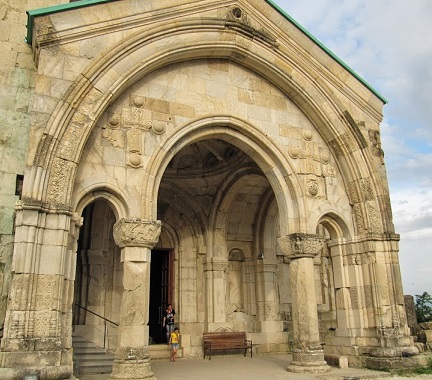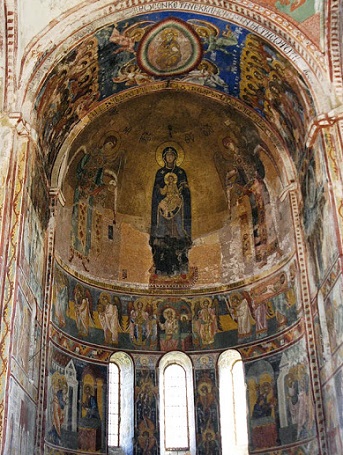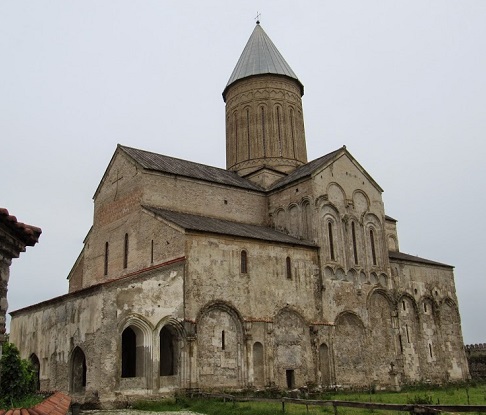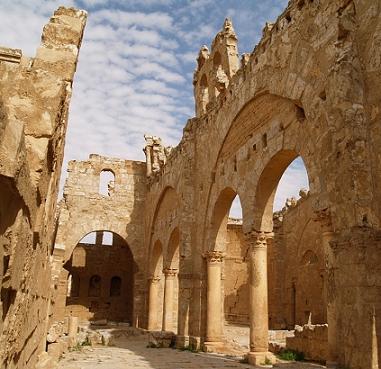|
|
Byzantine
Art
Byzantine art and architecture are the artistic
landmarks of the great Byzantine Empire. The empire covered Mediterranean
Europe and Asia Minor from the 4th to the 15th centuries A.D., emerging
naturally from the Roman Empire after 330 A.D. when the Roman Emperor
Constantine moved it's capital east from Rome
to Byzantium. The metropolis of New Rome was renamed
Constantinople and is present day Istanbul in Turkey,
located on the Bosphorus dividing Europe and Asia. The empire endured
for more than a millennium until the capture of Constantinople
by the Ottoman Turks in 1453, leaving way for the Ottoman Empire.
Present Turkey and Greece were at the heart of
the Byzantine Empire, which was based on christian religion and
dominated by greek language and traditions. The east coast of Italy
was a major landmark, where Ravenna
was the capital city of the
Western Roman Empire in the 5th and 6h centuries and Venice
took over the control of the area in the middle ages. Various dynasties
controlled the Byzantine empire, particularly flourishing under
the reign of Emperor Justinian about 550 A.D., when it's
coverage reached from Italy to North-Africa and Israel. Artistic
revivals took place during the 9th century Macedonian dynasty and
the 12th century Byzantine Renaissance. Byzantine architerture is
characterized by it's central-shaped domed churches with atriums
and round arches on roman-style columns. The golden interior mosaic
decorations are famous artistic expressions, influenced by the early-christian
buildings from Rome and by styles
from the orient. In turn, byzantine art greatly influenced the Romanesque
and medieval styles in the west and the later Ottoman styles in
the east. The most important Byzantine monuments can be found today
in Turkey, Greece and Italy. The former capital cities of Istanbul
and Ravenna present a great wealth
of early byzantine churches and monuments to the visitor, as well
as collections of great mosaics. In
Greece, the cities of Athens and Thessaloniki preserve
many churches, while inside the country some great monasteries and
mountain churches can still be visited. Many more countries in Eastern
Europe and Asia Minor preserve byzantine churches, often in very
diverging styles. The late-byzantine architecture of the Orthodox
church in Russia and Ukraine or the early churches of Georgia and
Armenia in the east of the empire are some distinct examples. On
this page we present a small overview of Byzantine monuments organized
per country, not meant to be complete.
[Turkey]
[Greece] [Italy] [Croatia]
[Bulgaria & Macedonia] [Russia
& Ukraine] [Armenia & Georgia ]
[Other countries]
Interactive map
Click on below map to go to the Google Maps page localising these
buildings.
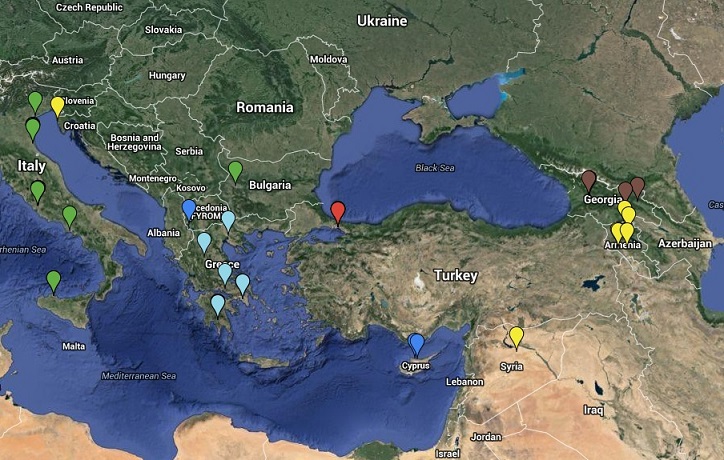
 TURKEY
TURKEY
Istanbul preserves the fragments of about 40 byzantine churches,
mostly converted into mosques. Highlights are the amazing Hagia
Sofia cathedral and the mosacis of the Chora monastery. More monuments
can be found at the ruins of Ephesus and Ani, in Trabzon, and at
the mountain churches of Goreme in Cappadocia.
|
Istanbul (Turkey), Hagia Sofia : exterior |
|
Istanbul (Turkey), Hagia Sofia : interior |
|
Istanbul (Turkey), Hagia Sofia : dome |
|
Istanbul (Turkey), Chora monastry
(Kariye Camii) : exterior |
|
Istanbul (Turkey), Chora monastry
(Kariye Camii) : mosaics |
|
Istanbul (Turkey), Pammakaritos church
(Fethiye Camii) : exterior |
|
Istanbul (Turkey), Pammakaritos church
(Fethiye Camii) : mosaics |
|
Istanbul (Turkey), Hagia Eirene |
|
Istanbul (Turkey), St Sergius and
Bacchus (Kucuk Aya Sofia) |
|
Istanbul (Turkey), Pantocrator church
(Zeyrek Camii) |
|
Istanbul (Turkey), Yerebatan Sarayi
(Basilica Cistern) |
|
Ani (Turkey), the city of 1001 churches |
 GREECE
GREECE
Greece was at the heart of the byzantine empire and retains many
small churches and larger monasteries. Most important monuments:
Athens and Thessaloniki (both preserve many byzantine churches),
the inland monasteries of Daphni and Hosios Loukas, the mountain
monasteries of Meteora, the late-byzantine churches of Mystras and
the church of Monemvasia.
|
Athens (Greece), Agii Apostoli : exterior |
|
Athens (Greece), Agii Apostoli : dome |
|
Athens (Greece), Kapnikarea |
|
Athens (Greece), Mitropolis |
|
Thessaloniki (Greece), St Demetrius |
|
Mystras (Greece), Agi Theodori |
|
Mystras (Greece), Pantanassa |
|
Mystras (Greece), Panagia Odigetria |
|
Mystras (Greece), Agia Sophia |
 ITALY
ITALY
The most important monuments are located in Ravenna
and Rome, refer to the dedicated pages for
a detailed desciption. In the north, San Marco at Venice and Torcello
in the Venetian laguna are not to be missed. In the south, Stilo
in Calabria and the churches at Sicily such as Palermo and Cefalu
present a very distinct arab-norman byzantine style.
|
Ravenna
(Italy), S. Apollinare in Classe |
|
Ravenna
(Italy), S. Apollinare Nuovo |
|
Ravenna
(Italy), Battistero degli Ariani |
|
Roma
(Italy), S. Prassede |
|
Roma
(Italy), S. Maria in Domnica |
|
Venezia (Italy), S. Marco |
|
Venezia (Italy), S. Marco |
|
| Palermo (Sicilia), Cappella
Palatina : les mosaiques |
|
| Palermo (Sicilia), Martorana
(S. Maria dell'Ammiraglio) |
|
| Castiglione di Sicilia
(Sicilia), la Cuba |
 CROATIA
CROATIA
The Euphrasian basilica in Porec is the most important byzantine
church in Croatia. Smaller examples can be found in Pula or Nin.
|
Porec (Croatia), Euphrasian basilica |
|
Porec (Croatia), interior |
|
Porec (Croatia), apse mosaics |
|
Pula (Croatia), St-Maria-Formosa |
|
Pula (Croatia), St-Nicholas |
 BULGARIA & MACEDONIA
BULGARIA & MACEDONIA
The most important monuments of Bulgaria are the churches of Sofia
and Nessebar. In Macedonia, many smaller churches can be found,
for example in Ohrid (various monuments) and Gorno Nerezi (near
Skopje).
|
Sofia (Bulgaria), St-George |
|
Nessebar (Bulgaria), Christ Pantocrator |
|
Ohrid (Macedonia), S. Sofia |
|
Ohrid (Macedonia), S. Sofia |
|
Ohrid (Macedonia), S. Jovan Kaneo |
|
Ohrid (Macedonia), S. Bogorodica Peribleptos |
|
Ohrid (Macedonia), S. Bogorodica Peribleptos |
|
Ohrid (Macedonia), Plaosnik baptistry |
|
Ohrid (Macedonia), S. Naum |
|
Kurbinovo (Macedonia), S. George |
 RUSSIA & UKRAINE
RUSSIA & UKRAINE
The most important byzantine monuments of Russia are located in
Vladimir and around the town of Novgorod. In Ukraine, the churches
of Kiev and Chernihiv are remarkable examples of the Orthodox byzantine
style.
|
Novgorod (Russia), St Sofia |
 ARMENIA & GEORGIA
ARMENIA & GEORGIA
Many small hilltop monasteries in deserted rough landscapes. Very
particular style and decoration. Most important monuments in Armenia:
the churches of Edjmiadzin, Geghard, Hagardzin, Haghbat, Sanahin
and Zvartnots. In Georgia: Alaverdi, Gelati, Jvari, Kutaisi and
Mtskheta.
|
|
Edjmiadzin (Armenia), St-Hripsime
|
|
|
Kutaisi (Georgia), Bagrati Cathedral |
 OTHER COUNTRIES
OTHER COUNTRIES
Byzantine monuments can be found in many other countries in eastern
Europe and Asia Minor, including Romania, Serbia, Cyprus, Egypt,
Israel, Jordania and Syria. Great variety in styles, architecture
and decoration.
|
|
Jerusalem (Israel), St Sepulchre |
|
Rasafa (Syria), St Sergius |
[top]
[home] [contact]
|
